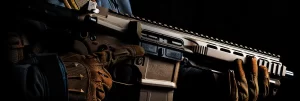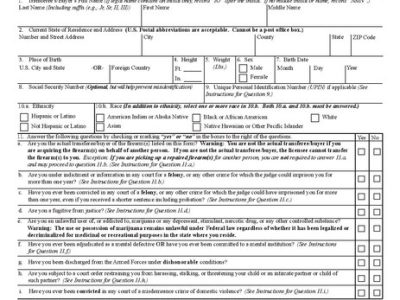Like any government bureaucracy, paperwork is a large part of the process of approving NFA weapons at the ATF. Once all of the applications have been submitted and the tax stamps received, many owners of these items wonder how to best maintain all of the records associated with possessing NFA property. It’s helpful to think of three kinds of paperwork- that which you submit, that which you carry with you, and that which you keep at home.
NFA Paperwork for Submission
Whenever you make a change to your trust that includes altering the physical location of the restricted items, the ATF must be notified. The Form 20 is used for this purpose and has two different functions. If you are moving to another house, whether across the country or down the road, the Form 20 must be filled out to reflect that the weapons will be kept permanently in a new place. It is best practice to submit the Form 20 at least 2 months ahead of the move.
On the form, there is a section where you will list the date that the items will be moved, and whether or not you are planning to return to the old location. For permanent moves, select the option that you will not be returning. The Form 20 is also used for obtaining permission to transport NFA weapons or accessories across state lines on a temporary basis. This is a popular option for those who compete in shooting events or hunt in another state.
To utilize the Form 20 for this purpose, you may either submit a Form 20 with the dates you will be leaving and returning before an event, or you can set up the dates so that you are covered for the year if you plan to go back and forth frequently. Either way, it is important that the Form 20 be received and approved before you depart.
NFA Paperwork to Carry
Once the tax stamp has been received for an NFA item, it must be carried with that item to prove that it has been legally registered. The exact details of how it should be carried have not always been very explicitly conveyed by the ATF. It is considered a good idea to carry a copy of the tax stamp with the item while keeping the original at home in your files. Due to the fact that tax stamps in trust names do not also list the name of the individuals in the trust, it is also a good idea to keep a copy of your trust with the item.
This is especially important if you are a co-trustee on the trust. For example, if a suppressor is listed under “ABC Trust,” there is no way to prove that you are a co-trustee on that trust without a copy of the trust document. As trust documents can be lengthy, keeping a digital copy of the trust handy is usually sufficient to show a game warden or law enforcement officer. When traveling out of state, bringing a paper copy of both the trust and the tax stamp can be a prudent decision. A digital or paper copy of the approved Form 20 is also required when crossing state lines.
Keep in mind that you are not allowed to travel through states where NFA items are prohibited, even with an approved Form 20 in hand for your destination. Many people believe that since you are not stopping in the state where an item is prohibited, it is legal to simply travel through it. This is not the case. Once you cross into that territory, you are beholden to their rules. If your destination lies on the other side of a state which does not allow possession of your item, you will need to detour around that state.
NFA Paperwork for Home
While most NFA aficionados are conscientious about submitting paperwork to the ATF, properly maintaining these records at home is much less common. This can create a legal hassle for those managing your estate upon your death. Any time an approved tax stamp is received from the ATF, that original document should be placed in a safe or in your filing cabinet at home. There is no need to keep the original Form 4 or Form 1 applications, just the final stamp will suffice.
As all the model information is listed on the tax stamp, it is easy to match up the stamp to the weapon or accessory. Any approved Form 20 should be maintained in these files as well. Permanent changes of address should be kept in the files for the duration of the time you own the items, but temporary Form 20s may be discarded after the dates listed on the forms expire.
Any documents which prove that an item has been sold, especially in the case of a private party sale, need to be maintained in your files. Of course, for NFA items, those private party sales will also require approved Form 4 from the ATF in order for the transfer of property to occur.
The Gun Trust
The trust itself must be maintained with all updated address changes, changes to co-trustees, changes to beneficiaries, and updates to trust property. For trusts drafted by NFA Lawyers, these changes are achieved through filling out a trust amendment for the appropriate update, signing, and dating the amendment.
Keep all amendments along with the original copy of your trust, so that the changes that occurred over the life of the trust can be easily followed. These amendments do not need to be sent to the ATF; they are just for your personal files. Maintaining updated and complete trust documents ensures that managing the NFA part of your estate will be easy and worry-free for your executor and beneficiaries.



 All About Transfers
All About Transfers